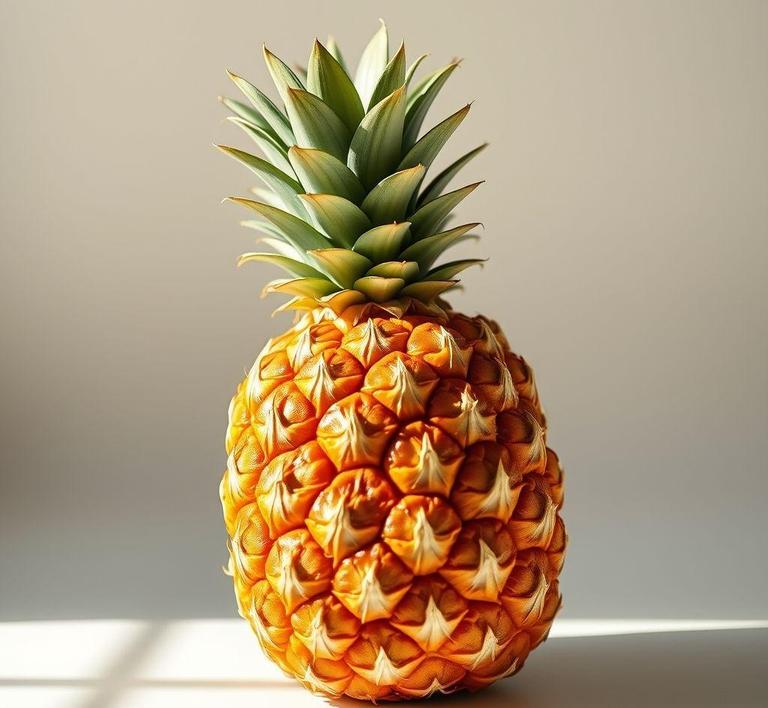Refreezing pineapple might seem a little odd at first, but it’s actually a great way to preserve those sweet, tropical flavors for later use. Whether you’ve bought too much, chopped it up for a smoothie, or just want to save leftovers from a fresh batch, refreezing pineapple can be a game-changer. In this guide, we’ll walk you through the best ways to freeze and refreeze pineapple to keep it tasting just as fresh as the day you cut it. So, if you’re wondering how to keep that juicy, delicious fruit around for a little longer, you’ve come to the right place!
Can You Refreeze Pineapple?

Yes, you can refreeze pineapple, but with several caveats. Pineapple, like many fruits, has a high water content-nearly 86%-which makes it particularly susceptible to texture degradation during freeze-thaw cycles. Whether the fruit is fresh, pre-cut, or part of a blended mix, once it’s been frozen and thawed, its structure begins to change. Thawing allows water within the pineapple’s cells to expand, rupture the delicate cell walls, and then leak out when defrosted, leaving the pineapple softer and sometimes mushy.
Refreezing is technically safe, provided the pineapple has been thawed properly (i.e., in the refrigerator and not at room temperature or in warm environments that promote bacterial growth). However, while it won’t make the fruit dangerous to eat, it will almost certainly alter its taste, texture, and visual appeal. For culinary applications where texture is less critical-like in smoothies, sauces, or baked goods-refrozen pineapple can still be perfectly serviceable.
How To Refreeze Pineapple?
If you’ve decided to refreeze pineapple, either out of practicality or to reduce food waste, follow these steps to do it properly and preserve as much quality as possible:
-
Assess the Condition:
- Only refreeze pineapple that has been thawed in the refrigerator and hasn’t been left out for more than 2 hours at room temperature.
- Discard any pineapple that has a sour smell, slimy texture, or signs of spoilage.
-
Drain Excess Liquid:
- After thawing, pineapple will often release a considerable amount of juice. Gently drain off this liquid to reduce ice crystal formation during refreezing.
-
Portion and Package:
- Divide the pineapple into usable portion sizes so you don’t need to refreeze again.
- Place portions into freezer-safe airtight containers or heavy-duty resealable bags. Remove as much air as possible to minimize freezer burn and oxidation.
-
Flash Freeze (Optional):
- For diced or chunked pineapple, you can lay the pieces in a single layer on a baking sheet lined with parchment paper and freeze for 1-2 hours before transferring to containers. This prevents clumping and allows you to remove only what you need later.
-
Label Clearly:
- Mark containers with the refreezing date and a note that the contents have been refrozen. Aim to use refrozen pineapple within 1-2 months for best results.
Quality Impact
The primary concern when refreezing pineapple is quality-especially its texture and flavor. Here’s what changes and why:
-
Texture:
- Upon the initial freeze, water inside the pineapple’s cells forms ice crystals that rupture cell walls. Thawing causes the pineapple to become noticeably softer. Refreezing exacerbates this, often resulting in a fruit that is mushy and limp. This is especially evident in fresh pineapple as opposed to canned or already frozen commercial products, which may contain stabilizers to mitigate this effect.
-
Flavor:
- While pineapple’s robust acidity and natural sweetness can hold up well in the first freezing cycle, refreezing might mute its bright tropical tang. The breakdown of cellular walls can also lead to the loss of aromatic compounds, making the flavor seem flatter or slightly fermented if not handled properly.
-
Appearance:
- Refrozen pineapple often darkens in color or becomes more translucent and pale. This can be visually unappealing if the fruit is being served fresh in fruit salads or garnishes.
-
Nutritional Value:
- Vitamin C, which is abundant in pineapple, is somewhat sensitive to temperature fluctuations. Refreezing may cause minor nutrient loss, particularly in this vitamin, although the overall nutritional impact is generally minimal unless the fruit undergoes prolonged or repeated thawing cycles.
While refreezing pineapple is safe under the right conditions, it’s a compromise between convenience and culinary quality. The biggest trade-off is texture, with refrozen pineapple often losing its firm, juicy bite and becoming mushier. However, for blended uses such as smoothies, sorbets, jams, and cooked dishes, refrozen pineapple remains a viable and delicious ingredient. The key is to handle the fruit with care during the thawing and refreezing process, and to temper expectations around appearance and texture.
Is It Safe To Refreeze Pineapple?
Refreezing pineapple can be safe, but it largely depends on how it was handled during and after thawing. Pineapple, like many fruits, contains a high water content and natural sugars, which makes it relatively resilient to freezing and thawing cycles. However, safety and quality concerns arise when the fruit is exposed to temperatures above freezing for extended periods, allowing bacteria to multiply.
If pineapple was thawed in the refrigerator and kept at a safe temperature (below 40°F or 4°C), refreezing is generally safe. The cold environment slows bacterial growth, reducing the risk of foodborne illness. However, if the pineapple was left out at room temperature for more than two hours (or one hour in hot environments), it enters the ‘danger zone’ where bacteria multiply rapidly, and refreezing is not recommended.
Moreover, pineapple that has been frozen, thawed, and refrozen will experience a decline in texture and flavor. Ice crystals that form during freezing rupture cell walls, leading to a mushier, less appealing texture after thawing. Therefore, while it can be safe to refreeze pineapple under proper conditions, it is important to consider the balance between safety and quality.
Signs That Pineapple Should Not Be Refrozen
Determining whether pineapple should be refrozen involves careful observation of its condition post-thawing. Here are key signs indicating the fruit is no longer suitable for refreezing:
- Off Odor: Fresh pineapple emits a sweet, tropical aroma. If you detect a sour, fermented, or rotten smell, it’s a clear indicator of spoilage. Microbial activity often produces these off-odors, signaling the fruit has gone bad.
- Slimy or Mushy Texture: While pineapple naturally softens when frozen, an excessively slimy or overly mushy feel suggests bacterial or fungal growth, making it unsafe.
- Discoloration: Pineapple flesh should be vibrant yellow or golden. Any dark spots, browning, or grayish areas indicate oxidation or decay.
- Presence of Mold: White, green, or black mold spots are a definitive sign the pineapple has spoiled and should never be refrozen or consumed.
- Excessive Liquid or Leakage: If the thawed pineapple has released an unusual amount of liquid, it might mean the cell structure is severely broken down, leading to poor quality and potential microbial contamination.
If any of these signs are present, discard the pineapple instead of refreezing it, as consuming spoiled fruit can lead to food poisoning.
Common Refreezing Mistakes
Refreezing pineapple might seem straightforward, but several pitfalls can degrade the fruit’s quality or compromise safety:
- Refreezing After Room Temperature Thawing: Leaving pineapple out on the counter to thaw can lead to bacterial growth. Refreezing in this state traps bacteria, which might not be killed and could cause illness.
- Refreezing Multiple Times: Each freeze-thaw cycle damages pineapple’s texture and flavor. Repeated cycles lead to mushy fruit, off-flavors, and loss of nutritional value.
- Not Storing Properly: Refreezing pineapple in loosely sealed containers or exposed to air can cause freezer burn, drying out the fruit and altering its taste.
- Ignoring Cross-Contamination: Thawed pineapple should be handled with clean utensils and surfaces. Any contamination before refreezing can introduce pathogens.
- Refreezing Pineapple That’s Already Spoiled: Sometimes people mistake slight texture changes for spoilage, but once spoiled, pineapple should never be refrozen.
Avoiding these mistakes ensures your pineapple stays as safe and tasty as possible through its freezing journey.
Tips And Tricks
To maximize pineapple’s safety, texture, and flavor when freezing and refreezing, follow these expert tips:
- Freeze Fresh Pineapple Quickly: Cut pineapple into chunks and freeze in a single layer on a baking sheet before transferring to airtight containers. This prevents large ice crystals and helps retain texture.
- Use Vacuum-Sealed Bags: Vacuum sealing removes air, which reduces freezer burn and helps maintain flavor during freezing and refreezing.
- Thaw in the Refrigerator: Always thaw frozen pineapple in the fridge to keep it at safe temperatures. Avoid thawing on countertops.
- Use Within a Reasonable Time: Ideally, consume pineapple within 6 months of freezing to maintain the best quality.
- Use Refrozen Pineapple in Smoothies or Cooking: If the texture is compromised, refrozen pineapple is excellent in smoothies, sauces, or baked goods, where texture matters less.
- Label and Date Packages: Keep track of freezing and refreezing dates to avoid consuming pineapple that has been frozen too long.
- Don’t Refreeze Pineapple That’s Been Left Out: If pineapple has been thawed at room temperature for over two hours, discard it.
Conclusion
Refreezing pineapple is a nuanced process that hinges on how the fruit is handled after thawing. While it is generally safe to refreeze pineapple that has been properly thawed and stored at safe temperatures, doing so repeatedly or after improper thawing can lead to quality loss and potential health risks. Recognizing signs of spoilage and avoiding common mistakes is crucial for maintaining safety and enjoyment.
By following smart freezing techniques and thoughtful handling, you can extend the life of pineapple while preserving its vibrant flavor and nutritional benefits. When in doubt, always prioritize food safety – it’s better to discard questionable pineapple than risk foodborne illness.
If you love pineapple as much as many do, taking these precautions ensures you enjoy this tropical delight safely and deliciously, anytime you crave a sweet, juicy bite.


